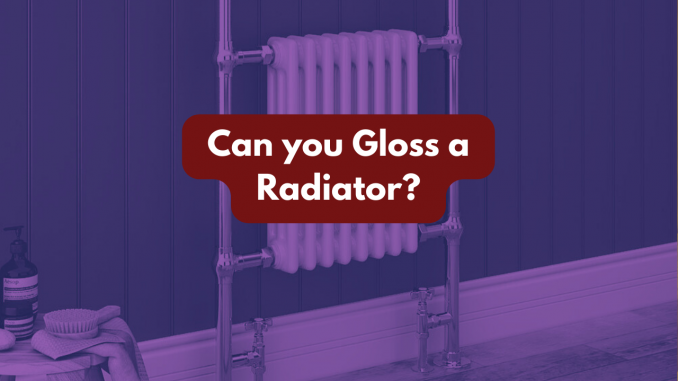
Gloss paint, with its resilient composition and lustrous appearance, proves to be an ideal choice for coating radiators. This type of paint is frequently applied to various elements within a home, including woodwork, skirting boards, door frames, and notably, radiators. Its durability and glossy finish make it a popular option for enhancing both the aesthetic appeal and longevity of radiators.
Radiators play a pivotal role in maintaining optimal temperatures in our homes, but what about enhancing their aesthetic appeal? One way to achieve this is by glossing your radiator, turning it into a stylish focal point that seamlessly integrates with your interior design. In this blog post, we’ll delve into the intricacies of glossing a radiator, providing you with step-by-step instructions and valuable tips.
Why Gloss Your Radiator?
Before we dive into the process, let’s explore the benefits of glossing your radiator. Not only does it add a touch of sophistication to your living space, but it also helps protect the radiator surface from wear and tear. The glossy finish is not only visually appealing but also easier to clean, making maintenance a breeze.
Materials You’ll Need
To embark on your radiator glossing journey, gather the following materials:
- Sandpaper: Start with fine-grit sandpaper to smooth the radiator surface.
- Primer: Choose a suitable primer to ensure proper adhesion of the paint.
- High-Quality Gloss Paint: Opt for a paint specifically designed for radiators.
- Paintbrushes and Rollers: Different sizes for various parts of the radiator.
- Painter’s Tape: To protect surrounding areas from accidental paint splatters.
- Drop Cloth or Newspapers: To cover and protect the floor.
How to Gloss Your Radiator
1. Prepare the Surface:
- Turn off the heating system and let the radiator cool down.
- Use sandpaper to smooth out any imperfections on the surface.
2. Apply Primer:
- Apply a thin, even layer of primer to enhance paint adhesion.
- Allow the primer to dry completely before moving to the next step.
3. Choose the Right Paint:
- Select a high-quality gloss paint that is suitable for radiators.
- Ensure it complements your overall interior color scheme.
4. Protect Surrounding Areas:
- Use painter’s tape to cover adjacent walls, floors, and any other surfaces.
- Lay down a drop cloth or newspapers to catch any drips.
5. Paint the Radiator:
- Use a brush or roller to apply the first coat of paint evenly.
- Allow it to dry completely before applying additional coats as needed.
6. Inspect and Touch Up:
- Once the final coat is dry, inspect the radiator for any uneven areas.
- Touch up any imperfections with a small brush for a flawless finish.
The Dangers of Glossing a Radiator
While glossing a radiator can provide aesthetic benefits, it’s essential to be aware of potential dangers and considerations associated with this process:
- Heat Resistance:
- Radiators generate heat, and some types of gloss paint may not withstand high temperatures. Using paint that is not heat-resistant can lead to discoloration, peeling, or even emitting harmful fumes when the radiator is in use.
- Flammability:
- Certain gloss paints may contain flammable components. If the paint is not labeled as flame-retardant or suitable for high-temperature applications, it could pose a fire hazard when exposed to the heat produced by the radiator.
- Health Concerns:
- The process of glossing a radiator involves using paints and primers that may emit volatile organic compounds (VOCs) during application and drying. Prolonged exposure to VOCs can lead to health issues such as headaches, dizziness, or respiratory irritation. Ensure proper ventilation and use paints with low VOC content.
- Proper Ventilation:
- Insufficient ventilation during the painting process can lead to the accumulation of fumes, posing respiratory risks. Always ensure the room is well-ventilated by opening windows and doors, and consider using a mask to minimise inhalation of fumes.
- Surface Preparation:
- Inadequate surface preparation, such as failing to remove rust or properly sand the radiator, can affect the adhesion of the gloss paint. This may lead to a less durable finish and compromise the overall effectiveness of the paint.
- Compatibility with Previous Finishes:
- If the radiator has been previously coated with a different type of paint or finish, compatibility issues may arise. Incompatibility could result in peeling, cracking, or an uneven appearance. Consider consulting with a professional or conducting a small test patch before proceeding.
- Maintenance Challenges:
- Glossy surfaces tend to show scratches, fingerprints, and dust more prominently than matte finishes. While glossing can enhance aesthetics, it may require more frequent cleaning and maintenance to keep the radiator looking pristine.
To mitigate these dangers, it’s crucial to choose high-quality, heat-resistant gloss paints specifically designed for radiators. Always follow proper safety guidelines, use appropriate protective gear, and ensure good ventilation throughout the painting process. If in doubt, consulting with professionals or seeking advice from paint manufacturers can help address specific concerns related to glossing radiators.
Glossing a radiator is a fantastic way to marry functionality with style, transforming a utilitarian element into a design feature. By following this step-by-step guide and using high-quality materials, you can achieve a glossy radiator that not only enhances the aesthetics of your space but also stands the test of time. Elevate your home’s interior by giving your radiator the attention it deserves!


Leave a Reply